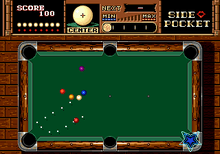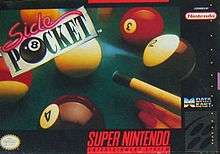Side Pocket
| Side Pocket | |
|---|---|
 Arcade flyer | |
| Developer(s) |
|
| Publisher(s) | |
| Composer(s) |
List
|
| Platform(s) | |
| Release |
Arcade
|
| Genre(s) | Cue sports |
| Mode(s) | Single-player, multiplayer |
Side Pocket (Japanese: サイドポケット Hepburn: Saido Poketto) is a pocket billiards video game originally released into arcades by Data East in 1986. The arcade version was eventually ported to the Nintendo Entertainment System and Game Boy, while an enhanced remake was later released on the Sega Genesis, Super Nintendo Entertainment System, and the Sega Game Gear. The game also spawned two sequels, as well as arcade spin-off series titled Pocket Gal.
G-Mode currently owns the intellectual property rights to the Side Pocket series, and licenses these games globally.
Gameplay

The primary play mode, called "Pocket Game", requires that the player sink all balls on the table within a set number of lives, as well as achieve a predetermined score to advance through four or five stages of play. The player earns points by sinking balls, sinking balls on consecutive shots, and sinking balls in numerical order. On occasion, a pocket will light up, and if the player sinks a ball into that pocket in the same shot, a bonus will be awarded in the form of points, extra lives or a bonus round. One life is lost if the player scratches or fails to sink a ball in two consecutive shots
In the two-player mode, the player can choose between Pocket Game or 9-Ball Game. In two-player Pocket Game, the game plays similarly, except the two players take turns and there are no lives; if one player misses or scratches, control of the ball simply changes to the other player. In 9-Ball Game, each player have three lives and one life is lost if a foul is committed. However, the lives will be restored if the player sinks a ball on the next turn.
In the Game Boy and Game Gear version, there is also an additional practice mode, which is essentially a single-player version of 9-Ball Game.
A variety of trick shot challenges are also available to the player(s), to earn additional points or extra life, requiring the player sink all balls into select pockets using a single shot. The player may put various spins on the ball, such as left and right english, and perform massés and jump shots.

The Genesis and SNES versions features a photo-realistic representation of the player character. The character is depicted as a man wearing a waistcoat and bowtie, possibly referencing the outfit commonly worn on English cue sports tournaments. In two-player mode, another character model is used; depicted as a mustachioed elderly man wearing the same outfit.
Reception
In reviewing the NES version, Computer Gaming World declared it "far and away the best billiards simulation ever published for any system". The features that went beyond realistic pool were especially praised as enhancing the game's play.[2]
Reviewing the SNES version, GamePro praised the variety of modes, the audio and graphical improvements over the NES version, and the realistic details. They recommended the game "for pool enthusiasts and casual video game pool players alike. There are plenty of great options and genuine pool strategies to keep serious players interested, and yet it's simple enough to play without the manual."[3] They gave the Game Gear version a more mixed review, commenting that the representation of the player's stick as a stream of balls is needlessly cumbersome, and that the graphics and sound are poor. However, they summarized, "Determining the precise angle and power for a shot can be harder than taking a geometry test, but it's definitely more fun."[4] Electronic Gaming Monthly also complained of poor sounds but were more impressed with the graphics, describing them as exceptional for a portable system. They praised the game for its trick shots and generally strategic gameplay and gave it a 6.25 out of 10.[5]
Entertainment Weekly gave the game a B- and wrote that "Insipid electronic lounge sounds are an integral component of Side Pocket (for Genesis), which presents American pool halls as a series of squeaky-clean (no beer stains on the felt here), nonconfrontational venues where your sole objective is to play pool — and not, say, impress your date with how many shots of tequila you can down in five minutes. Embodying this utilitarian approach is the game's hyper-realistic, overhead-angle table display — not as realistic, unfortunately, is its follow-the-dotted-line aiming system, which allows you to hit the cue ball in only about half a dozen places. An extensive trick-shot menu — apparently meant to compensate for this glaring limitation — is intriguing, but completely superfluous."[6]
Controversy
The Japan-only arcade spin-off series, Pocket Gal and Pocket Gal Deluxe, has attracted criticism for its inclusion of adult imagery and nudity, deemed inappropriate for younger players. This is typical of numerous Japanese arcade games, which feature adult imagery.
Sequels
The game has two sequels, Side Pocket 2 and Side Pocket 3.
References
- ↑ "Side Pocket trademark". U.S. Patent & Trademark Office. 1988-07-05. Retrieved 2015-05-31.
- ↑ Kunkell, Bill (July 1988), "Video Gaming World: Side Pocket", Computer Gaming World, p. 45
- ↑ "ProReview: Side Pocket". GamePro (55). IDG. February 1994. p. 121.
- ↑ "Side Pocket". GamePro (60). IDG. July 1994. p. 134.
- ↑ "Review Crew: Side Pocket". Electronic Gaming Monthly (59). EGM Media, LLC. June 1994. p. 40.
- ↑ https://ew.com/article/1992/10/30/side-pocket/